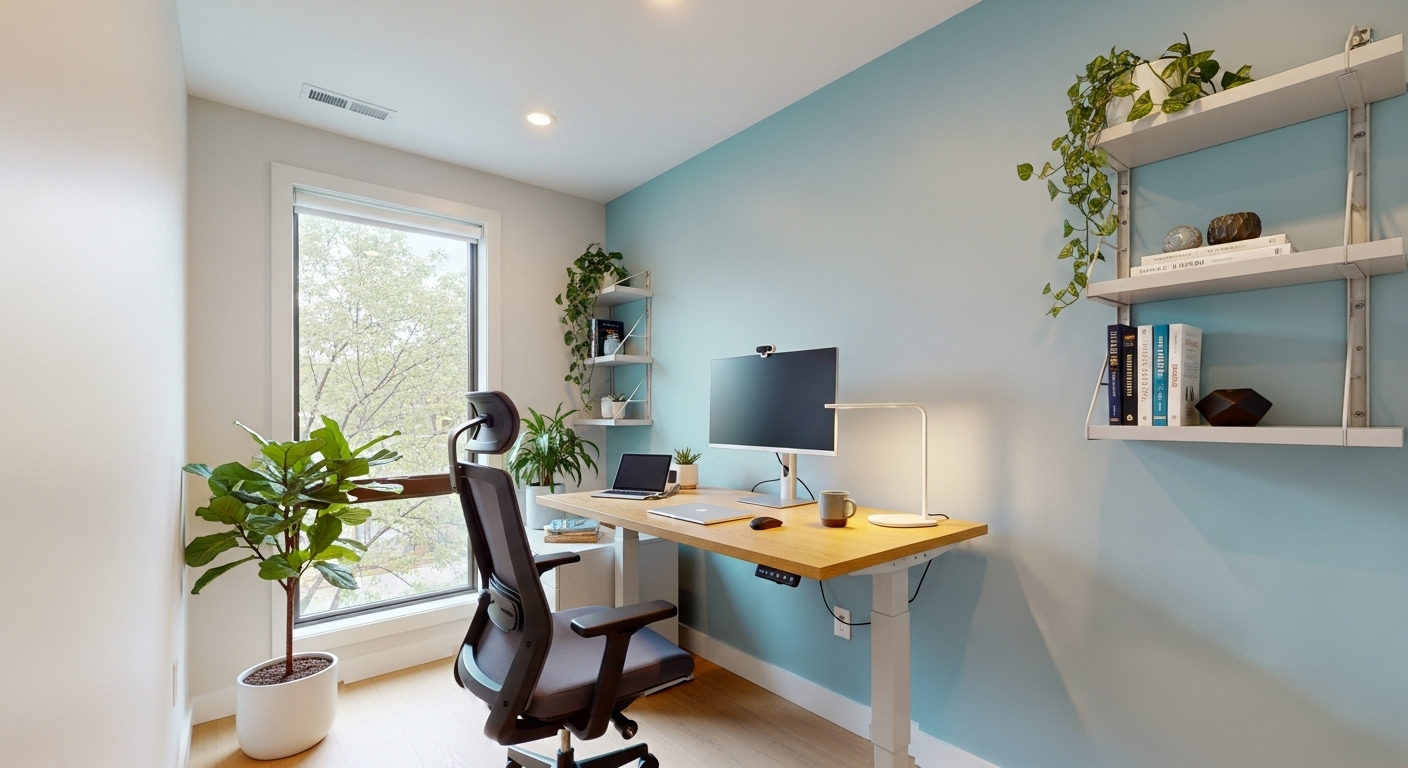The promise of remote work was one of freedom and flexibility. We pictured finishing tasks from a sun-drenched balcony or seamlessly integrating personal errands with professional duties. However, for many modern professionals, this dream has morphed into a different reality: an ‘always-on’ culture where the digital glow of a laptop screen is the first thing we see in the morning and the last thing we see at night. This phenomenon, known as ‘digital presenteeism,’ is the silent pressure to be constantly available, responsive, and visible online, often leading to burnout and blurred lines between work and life. Recent studies show that remote employees often work longer hours than their in-office counterparts, struggling to disconnect fully. This article will guide you through mastering the art of setting boundaries to not just survive, but truly thrive in a remote career. We will explore strategies to combat digital presenteeism, architect effective physical and digital divides, leverage asynchronous communication, protect your mental well-being, and ensure career visibility without sacrificing your personal life.
The Myth of Flexibility: Understanding Digital Presenteeism
Digital presenteeism is the modern professional’s paradox. While you have the flexibility to work from anywhere, there’s an underlying expectation to be reachable at any time. This pressure doesn’t come from a single source; it’s a complex mix of organizational culture, personal anxiety about performance, and the very technology that enables remote work. Platforms like Slack, Microsoft Teams, and instant email notifications create an environment where immediate responses are often perceived as a measure of productivity and commitment. Many employees fear that if they aren’t visibly ‘green’ online, their managers or colleagues will assume they are slacking off. This leads to performative work—keeping tabs open, responding to emails after hours, and joining optional meetings just to show you’re engaged. The consequences are significant. Extended work hours become the norm, deep, focused work is constantly interrupted, and the mental ‘commute’ that once separated the office from home evaporates. The result is a direct path to chronic stress and burnout, diminishing the very productivity and well-being that remote work was supposed to enhance. Understanding that this pressure is a systemic issue, not a personal failing, is the first step toward reclaiming control.
Architecting Your Boundaries: The Physical and Digital Divide
Creating a sustainable remote career hinges on building clear boundaries, both physical and digital. The first and most crucial step is establishing a dedicated workspace. This doesn’t have to be a separate room; it can be a specific corner of your living room or a designated desk. The key is that this space is psychologically associated with work. When you’re there, you’re working; when you leave, you’re not. This physical separation helps your brain transition between professional and personal modes. Equally important are your digital boundaries. Start by customizing your notification settings ruthlessly. Turn off all non-essential alerts on your phone and computer. Schedule ‘focus time’ blocks in your calendar, making it clear to colleagues that you are unavailable for meetings or instant messages. A powerful technique is to use separate user profiles or browsers for work and personal activities. This prevents work-related bookmarks and history from creeping into your evening browsing. Crucially, define and communicate your working hours. Set your status on communication apps to ‘away’ outside these hours and, most importantly, respect this schedule yourself. Resist the urge to check that ‘one last email,’ as it reopens the mental connection to work you’ve tried so hard to close.
Mastering Asynchronous Communication: Working Smarter, Not Longer
A key strategy to unplug without falling behind is to champion asynchronous communication. This approach decouples work from the necessity of being in the same place at the same time. Instead of relying on instant responses and back-to-back meetings, asynchronous work prioritizes thoughtful, well-documented communication through platforms like project management tools (Asana, Trello), shared documents, and detailed emails. This shift fundamentally changes the workday from reactive to proactive. It empowers you and your colleagues to work on tasks during your most productive hours, rather than being beholden to others’ schedules. To implement this, focus on clarity and context in your written updates. Instead of a quick ‘What’s the status on X?’, write a detailed message outlining what’s been done, what’s needed, and what the deadline is. This reduces the need for follow-up questions and real-time clarification. Advocate for reducing internal meetings, suggesting that many could be replaced with a detailed memo or a video recording. By moving away from a synchronous-first culture, you reclaim large blocks of uninterrupted time for deep work, which not only boosts your output but also significantly reduces the stress of being constantly on call.
Protecting Your Mental Real Estate: Strategies for Digital Wellness
In a remote setting, your mental and digital wellness are inextricably linked. The lack of a physical office environment means you must be deliberate about protecting your mental ‘real estate’ from the constant intrusion of work. One of the most effective strategies is scheduling regular ‘digital detox’ periods throughout your day. This can be as simple as taking a 15-minute walk without your phone or eating lunch in a different room away from any screens. These micro-breaks are essential for preventing digital fatigue and mental exhaustion. The much-discussed ‘Zoom fatigue’ is a real neurological phenomenon; our brains have to work harder to process non-verbal cues in video calls. Combat this by questioning the necessity of video for every meeting. Suggest audio-only calls or phone calls when possible to give your eyes and brain a rest. Furthermore, establish clear non-work rituals to bookend your day. Your morning routine should involve activities that aren’t work-related, such as exercise, meditation, or reading, before you even open your laptop. This ensures you start the day on your own terms. Similarly, an evening routine should help you decompress and disconnect, signaling a definitive end to the workday and allowing your mind to fully recharge.
Visibility Without Burnout: Advancing Your Career Remotely
A common fear among remote professionals is that ‘out of sight, out of mind’ will apply to their career progression. Many overcompensate by being hyper-available, leading directly to burnout. The key to career advancement is not about constant visibility, but about impactful visibility. Shift your focus from demonstrating presence to demonstrating progress. Keep a ‘win’ document that tracks your accomplishments, successful projects, and positive feedback. Share this information proactively and concisely during your one-on-one meetings with your manager. These regular check-ins are more critical than ever in a remote setup. Use them to align on priorities, discuss challenges, and clearly communicate your career aspirations. Don’t let your manager guess what you’ve achieved. Beyond your direct role, engage in virtual networking within the company. Join special interest Slack channels, volunteer for cross-departmental projects, or offer to mentor a new hire. This builds your reputation and network organically. By focusing on the quality and impact of your contributions and communicating them effectively, you prove your value far more powerfully than a perpetually ‘green’ status icon ever could. This strategic approach ensures your career continues to grow while your well-being remains intact.
The Ritual of the Shutdown: Reclaiming Your Personal Life
The most critical practice for a sustainable remote career is the shutdown ritual. This is a consistent set of actions you perform at the end of each workday to signal a complete break from your professional responsibilities. Its power lies in its consistency, creating a psychological boundary as strong as the physical act of leaving an office. Your ritual can be simple but must be non-negotiable. It begins with a final check of urgent communications, followed by planning for the next day. Write down your top 3-5 priorities for tomorrow. This act of ‘brain dumping’ prevents tasks and anxieties from swirling in your head all evening. Next, methodically close every work-related tab, application, and window on your computer. If you have a dedicated workspace, tidy it up. This physical act reinforces the mental closure. Finally, the ritual must conclude with an action that marks the transition to your personal life. This could be changing your clothes, going for a walk, playing a specific song, or spending ten minutes on a hobby. This final step is the ‘lock on the door’ of your workday. By consistently performing this shutdown ritual, you train your brain to disengage, allowing you to be fully present in your personal life, rest properly, and return to work the next day refreshed and focused rather than fatigued.
Conclusion
The evolution of remote work offers unprecedented opportunities, but it demands a new level of personal discipline and intentionality. The default mode of a digitally connected career is a slow slide into burnout, where the lines between work and life are not just blurred but completely erased. Thriving as an unplugged professional isn’t about working less; it’s about working smarter and living more fully. By actively combating digital presenteeism, you reclaim your agency. By architecting firm physical and digital boundaries, you create the necessary space for your mind to rest and recharge. Embracing asynchronous communication frees you from the tyranny of the urgent, allowing for deeper, more meaningful work. Prioritizing your digital wellness and strategically managing your career visibility ensures long-term sustainability and growth. Ultimately, the shutdown ritual ties it all together, serving as a daily declaration that your time is your own. True success in the modern remote landscape is measured not by hours logged online, but by the ability to deliver excellent work while cultivating a rich, fulfilling personal life. It’s time to take control, set your boundaries, and redefine your own terms for a successful and sustainable remote career.





